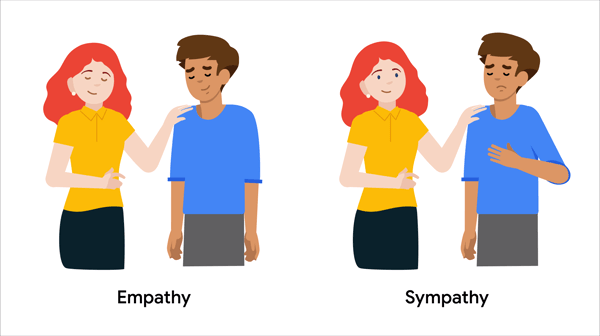Understand empathy in UX design
The name UX design says it all: the user’s experience is at the center of how we design products. The best way for you to create great user experiences is to know and empathize with your user. As you might recall, empathy is the ability to understand someone else’s feelings or thoughts in a situation.
As a UX designer, empathizing with users enhances the products you create because you experience the product as your user does. The better you are at anticipating a user’s desires and needs, the more comfortable the user will feel with your design, and the more likely they will be to engage with your product long-term.
So, let’s explore how empathy can make you a more effective UX designer!
How to empathize with users
If empathizing with users sounds like a big task, fear not! The ability to empathize with users is a skill that can be learned with practice. Here are six tips that can help you become a more empathetic UX designer.

Ask lots of questions. As a UX designer, you cannot make assumptions about the needs of your users. Instead, ask your users directly about their needs and wants, which your product design can address. Ask questions that begin with what, how, and why to gain a deeper understanding of your users’ perspective.

Become more observant. Shift your focus to the whole user and not just the words they are using. In interviews where the user is physically present or on a video recording, watching a user interact with you or your product can provide physical cues that can affect your research outcomes. To help capture observations, you’ll take detailed notes or even record your sessions with users.

Be an active listener. Active listening requires you to fully concentrate on, understand, and remember what is being said by the user you’re interacting with. Avoid getting distracted by where the conversation is going or what you might say next. In UX design, practicing active listening can help you get impartial feedback directly from your users, which you can apply to improve your designs.

Request input. It’s important that the feedback you receive is objective and unbiased. Friends or colleagues often provide biased, mostly positive feedback because they want to support or please you. So, it’s important to request input from a variety of sources and a diverse group of users. When asking for feedback, use open-ended questions to understand the user’s actual thoughts on the experience or product.

Have an open mind. We all have biases. Remember, a bias is favoring or having prejudice against something or someone, based on limited information. As UX designers, we have to set those biases aside to better empathize with others. Your goal is to understand users, not to complicate their feedback with your own opinions and emotions.

Keep current on UX research. Follow researchers and join online communities to stay up-to-date on the research that affects UX designers and the users you’re designing for. Research is always changing and evolving as we understand more about human psychology. Staying current will give you an advantage in how you understand and interact with your audience.
Empathy vs. sympathy
Empathy is sometimes confused with sympathy, but the two terms don’t mean the same thing. Empathy means understanding someone’s feelings or thoughts, often by feeling the emotions yourself. Sympathy is the experience of showing concern or compassion without feeling the emotions themselves.

By empathizing effectively with your users and doing your best to understand their needs, you build a great foundation for a product experience that will help solve their unique problems.
What does empathy mean to you?
Designing with empathy will enhance the products you create. By building deeper connections with users, you’ll better understand their perspectives and pain points. Finding that connection early can guide you down the right design path and save you from extensive revisions of your product during a later phase of the design process.
With a focus on empathy, you can design a product that offers users everything they need and more.
To learn more, check out this video on the power of empathy from Dr. Brené Brown.